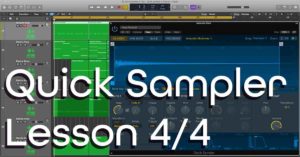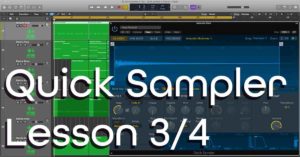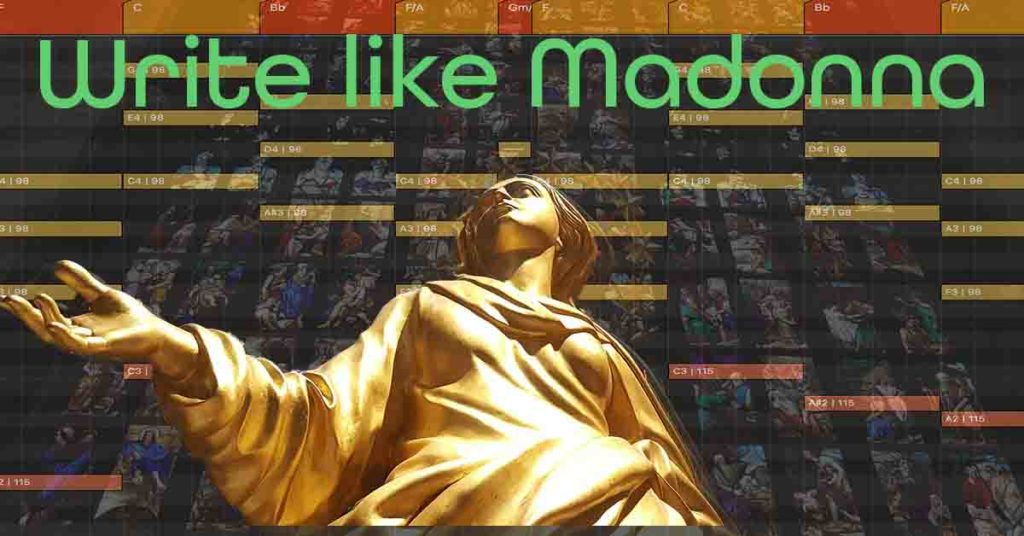
bemusiDarren
How Madonna Effortlessly Blurs Major and Minor Tonality
Like A Prayer
When I was at College studying for my A Levels I wrote an analysis on the music of Madonna, her influence on pop culture and how she redefined music as a female artist.
Like most of my classmates I left everything to the last minute and so at the 11th hour stayed up throughout the night reading and writing away in the hope of handing the whole thing in the following morning. 5000 words here we come!
The strange thing was upon opening the first page of the many books I had in front of me I remember reading the author recounting a story of Madonna going to a party and being told by a fortune teller that she’d never have a baby, to be honest it really passed me by at that moment in time and certainly wasn’t going to aid in a successful outcome in terms of an in depth and insightful analysis of her music and her impact on popular and alternative culture.
Many hours later around 6am and through bleary eyes I switch on the TV, standing on the steps of the set of Evita was Madonna with the headline she was pregnant. Safe to say my trust in the books I’d used that morning did not fill me with confidence for a solid grade or even an accurately informed study.
However, one thing it did give me was a respect for her music and the boundaries as an artist she was prepared to break down through music.
Like a Prayer
Like A Prayer was Madonna’s lead single to her fourth album written and produced by Madonna and Patrick Leonard. Stylistically it blended an 80s jangly funk rhythm, British rock style guitar along with Andreas Crouch’ gospel choir topped with a mellow organ providing a choral and chordal backdrop.
This in itself is a good example of how blending instrument groups from different styles can fit perfectly together creating a new or even unique sound in the context of what appears to be a ‘simple’ pop song. In todays modern culture of music it may seem harder than in the 80s to produce something a bit more unique but if you look hard enough think carefully about what sound you want and explore different styles of music there is still a wealth of inspiration out there you can draw new music from.
The arrangement makes use of stark contrasts between verse and chorus. The verse is sparse and deliberately simplistic. If you want to make something appear big put something small next to it; if you want to create intimacy make it small, soft and light.
The light sustained organ chords, percussion and soft choir provide the harmony leaving space for the intimate vocal confession. The chorus by contrast introduces an electronic syncopated bass courtesy of the iconic Minimoog and live playing by Guy Pratt, the up the tempo 16th note funk rhythm guitar and of course full drums.
Now, if you know the song this is all a bit obvious but what I think is interesting about this contrast is the keys tonality also runs in contrast too and is something you could try in your own music no matter what style you write.
The combination of contrast in both the arrangement and tonality creates a powerful music device. A musical triple whammy you could try yourself, blend of instrumental styles, contrasting key or the tonality that runs parallel to a contrasting musical arrangement.
Is It Major, Minor, Ionian or Aeolian?
So what do I mean by tonality? Tonality is the key that you are in, if your song is in the key of C major then the notes of the scale would be C D E F G A B. If you were playing in A natural minor the notes would be A B C D E F G, that same notes as C major but starting on A instead of C.
If the notes and chords are focused around C major then that would be the tonality, if the notes and chords are focused around and lead to the A then the tonality would be minor.
We could also say the above two tonalities could be referred to as modes. If the notes as described above were played around C major then the tonality could also be referred to as Ionian for major and Aeolian for minor if the notes focused on the A as described above.
So is it major or ionian?
Modes, as I’m sure you are aware go all the way back to the Ancient Greeks and over time developed into Gregorian Chant and other forms of modal music, eventually evolving into the diatonic modal system we use today, which has led to some confusion between modes and keys as the lines blur almost into one.
Some will argue C Major and C Ionian are technically the same and some will argue they are very different. Excluding modal history, when we think of keys we think in terms of chord movement, leading tones and progressions that lead diatonically to the ‘home’ chord and root note. Whereas with modes even though the are the same we tend to see them as more fluid, especially in Jazz music. Modal playing gives rise to more freedom, a jazz musician for example may not stay diatonically in one key, they may take a chord and decide which mode will be played over that chord.
For example, a jazz player may take the triad of C major and decide which mode is to be used to improvised over that one triad, that could be C Ionian or any of the other 6 modes. A composer working on a pop track staying diatonically in one key flips that idea round all chords and notes serve one key and a melody that remains in that key. Chords and notes are constructed to go on a journey from one chord to the next staying in one key from beginning to end.
In Like A Prayer the tonality or key flips between minor to relative major or if you want to Aeolian and Ionian! Technically you could argue the whole song is diatonically in Dm and never leaves the key and you’d be write to say that but I would argue that seeing the tonality as shifting from minor to major will help you to understand how brilliant the arrangement is and how you can apply the same technique for yourself.
Simple Tonal Shifting
Minor Tonality
The opening chords, after the choral intro are firmly placed in Dm, there’s no question of the key’s tonality.
Dm – C/D – Gm/D – Dm – C/D Gm/D
Dm – C/E – C7/Bb – F/A – F/C – C
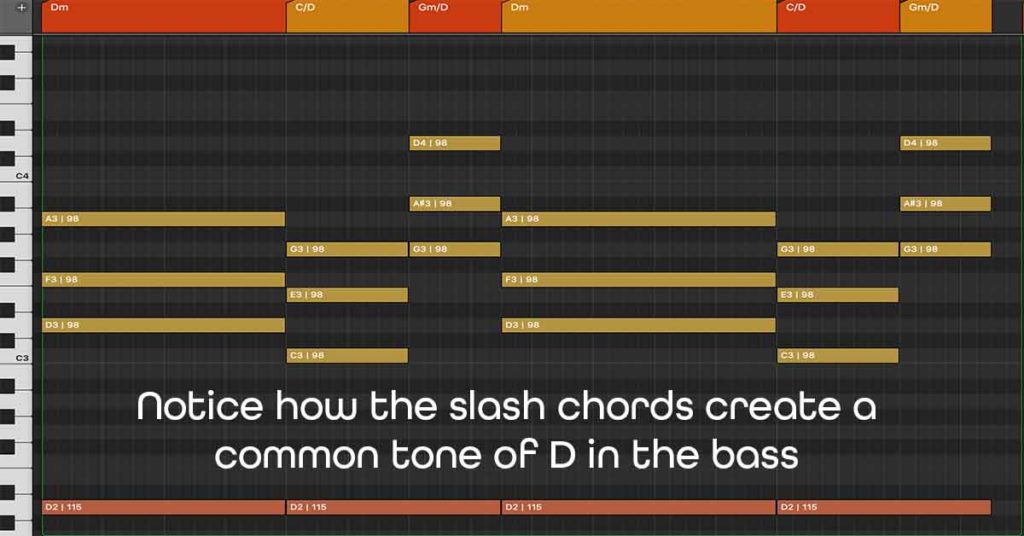
The rule of the shortest way states that you should always look for the shortest way when moving your harmony from one note to the next. Notice that the first four bars all sit on the note of D in the bass. This works well with the idea of a drone on the organ but also is a great way to connect the first three chords because the all have the same connecting note. This low D in the bass of the chord helps to keep the music in a state of repose, not really moving anywhere.
To create a subtle musical shift in the following four bars the chords stay largely the same but the bass note of E on the C/E chord and Bb of the C7/Bb chord suggest a clever but subtle shift in the direction of F major. The C7 seems to place the key towards the relative major as it goes from chords C7/Bb to F, the Bb flat being in the bass though masks that strong major movement but does provide a lift both vocally and harmonically. There’s a clever repetition of the C to F chords almost implying a subtle plagal cadence, which would be a IV to I chordal movement in C major. This device is a clever movement and shows the power of the cadence, it’s something I talk about in more detail in my Melody Masters course.
This, almost, Plagal feel works well with the song’s relationship to God but isn’t really noticed as the chord finally comes back to rest on Dm after the C. This strong harmonic movement where all notes are conquered when moving from C major to D minor avoids the feeling of finality due to the lack of leading tone. It’s a great musical device you could try when in the natural minor to avoid the music feeling like it has finished.
One final thought that is interesting, the typical looping in groups of four bars finishes with the opening verse holding the listener in suspense by adding one extra bar, this is followed by four bars on Dm. Ordinarily this is pop disaster but the chords are well crafted and the odd number of bars holds the listeners attention waiting for the release into the chorus.
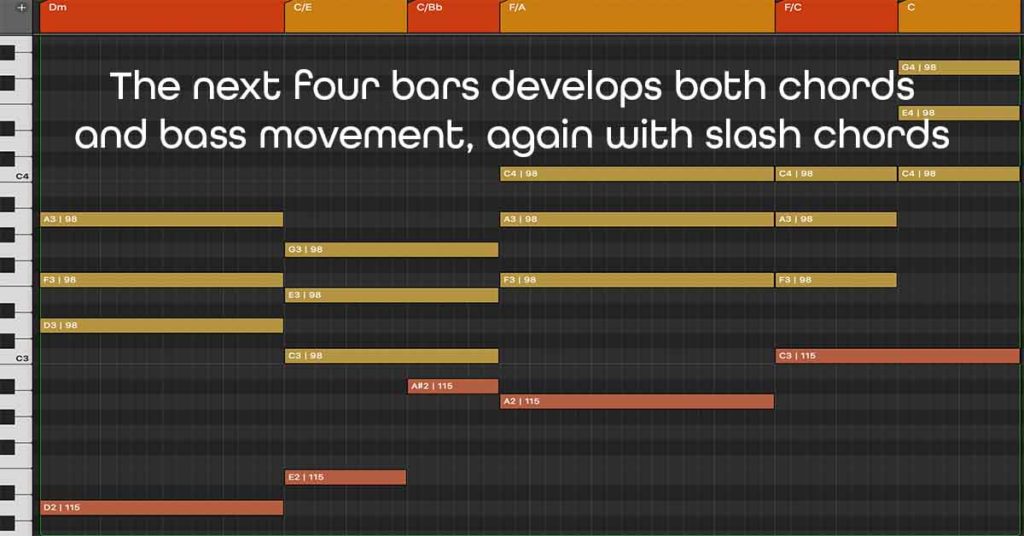
Major Tonality
The chorus, contrasting the opening chords focusses the tonality towards the relative major key by establishing a I – V – IV progression (in major). I’m not saying the key suddenly changes from Dm to F, I’m suggesting the tonal center of the chords shift towards F because of the strong harmonic movement around the F chord.
The F is at the start of the sequence and then immediately moves to the its strongest chords when in F, the dominant and sub dominant, theory and analysis is one thing but the real question is what does it sound like?
The music becomes optimistic and uplifting and most important of all acts as a complete contrast to the slightly tense opening. Something that can be learnt from the chorus is the use of slash chords. The line ‘I wanna take you there’ uses the slash chords F/A, F/D and Gm/D. All of which create a bass line that seems to push the chords to the minor tonality while the actual chord pushes to the major.
In your own music you could do the same, look at your chord progression, whether it has a major tonality or minor tonality and then use slash chords to either reinforce the key or add a bit of tension making the music and harmony more interesting.
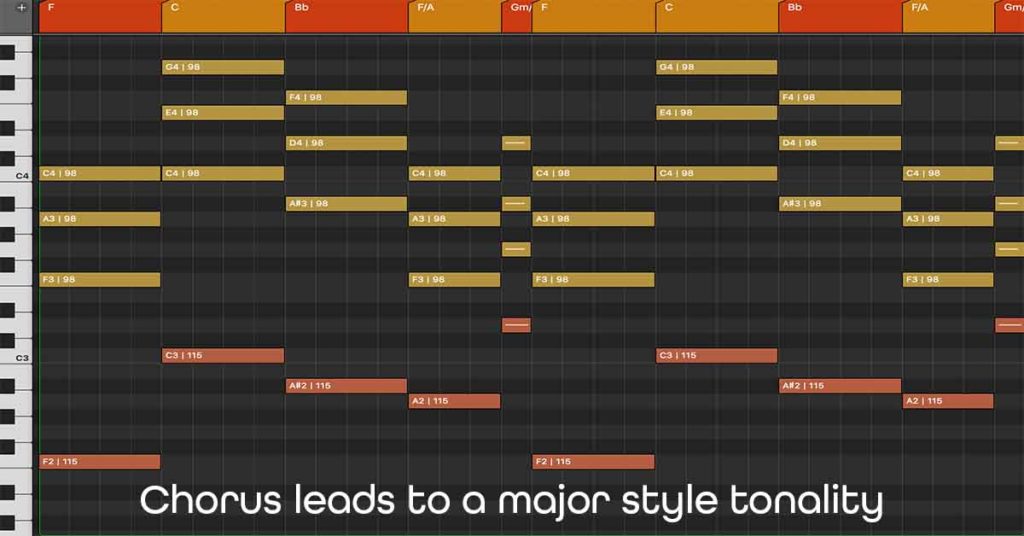
The song feels different there
I saw once on Reddit someone asking what was going on after the third verse “the song feels different there”. It’s actually a great question and is another example of both good song writing and the use of diatonic chords masterfully used to create tension and release that makes it feel different.
At 2m59s the tricky middle section enters, I say tricky because when writing a middle section your choices are go completely different or stay the same but change it slightly. In Like A Prayer it’s a masterful example of yet again playing with tonality and using the middle section as a means of tension, building towards the release of the chorus.
First the minor tonality is back firmly in Dm. The chords simply move back and fourth between Dm and C using slash chords (C/D), which creates a feeling of suspense, holding the listeners attention waiting for the release.
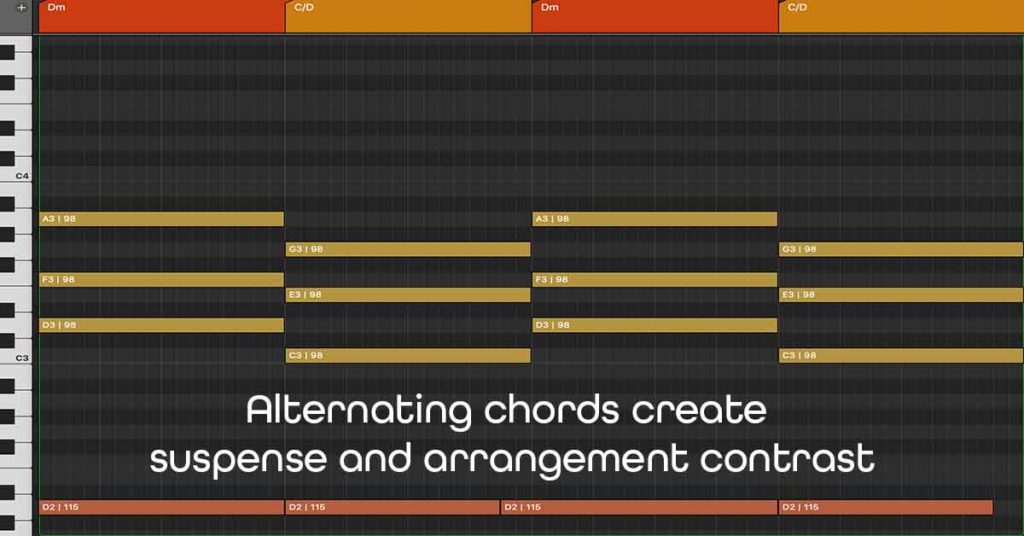
It may seem that simply going back and fourth between two chords is a bit simplistic? However, I would suggest this is a clever musical ploy. In the verse and choruses the chord progression keeps moving, structural contrast is created in the middle section by using two alternating chords, these two chords first create the fore mentioned contrast and second hold the listener in suspense waiting for the release, which comes in the form of the chords lifting out through Bb – C – F, again leading the tonality back to F major.
The clever thing leading out of the chorus isn’t just the feeling of shifting tonality but also the rhythmic harmony speeds up too. The Dm and C/D chords are four counts each but leading out of the middle section the chords switch to two counts per chord. This gives the feeling of pace and anticipation.
This time, by contrast, most of the chords are in root position creating strong harmonic movement as it builds towards the chorus. As the reddit user said it really ‘does feel different there’ but the release back to the chorus harmonically is perfect and satisfying.
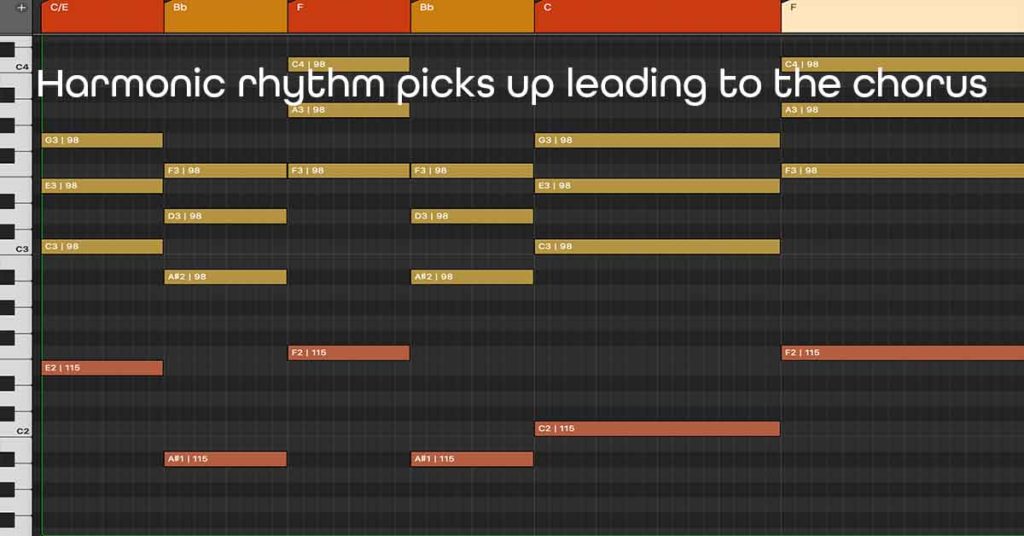
Simple is often beautiful
The progressions in Like A Prayer may be seen as simple when looking at it from the surface level but dig a little deeper and there isn’t a misstep in either production or composition. The careful use of chords, constantly shifting tonal center, use of slash chords all help in creating a perfect harmonic backdrop for a commercial hit. Slash chords add a little tension to the triads and demonstrates a mastery of chords, harmony, which ultimately enriches the brilliant melody.
When in a minor key I, IV and V triads cover all diatonic notes in a key, the same in major. What makes a piece of music exciting is creating a balance with your chords, making clever use of those three main chords, peppering them with other chords from the harmonised scale, considerate use of slash chords and the tonal center and the result will be a very simple but powerful harmonic backdrop for your music.
Contrasting the key between major and minor can be a clever way of using simple chords to create complex movement without ever actually leaving the key.
Sometimes the simplest solutions can result in the most listenable music!
To sum up if you want to add interest to your chords consider these tips:
- make use of shifting the tonality.
- look at using slash chords to create both interest in the bass and tension to the chord.
- make use of arrangement contrast by striping back the number of chords you’re using, perhaps even alternating just two chords.
- consider changing the rhythmic harmony of your chords at key moments to build tension and release.
- Listen to songs you wouldn’t normally listen too, look at the chords, the way the bass moves and ask yourself what can I learn from this?
If you liked this article and want to learn more about music and composition why not check out a be musi coaching program, there’s lots to learn and discover with programs covering both harmony and melody.
Stop Being Confused About Music
Subscribe to the be musi mailing list and learn more about music, be musi courses, how to develop your career, musicianship, and production skills.



